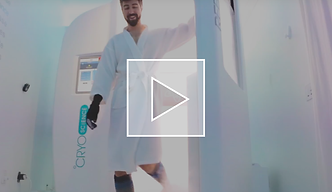
CRYOTHERAPY
Reach your potential
What is Cryo?
Cryo uses gasified nitrogen to activate the body’s powerfully healing “cold-shock response.” During the session, blood will rush to the core and revs up metabolism to create heat. After, blood returns to the extremities more oxygenated, and carrying newly released neurotransmitters that can dramatically lower inflammation, increase collagen levels, boost mood, accelerate recovery, and increase focus...among many other benefits.
TREATMENT OPTIONS
Whole Body
Activate your cold-shock response
3 Minute Treatment
Price of 1 Cryo Session
Whole Body Cryotherapy triggers an internal systemic anti-inflammatory response in the body. Clients frequently combine this treatment with local cryo, to treat problem areas both from the “inside out” as well as from the “outside in”.
Glow Facial
Naturally rejuvenate your skin
12 Minute treatment
Price of 1 Cryo Session
Our Glow Facial will leave your skin visibly smoother and plumper. Gentle
cryogenically-cooled air activates collagen production in the deeper levels of the skin. It increases the skin’s capacity to rejuvenate itself, regain elasticity, appear smoother, and gives your face a youthful glow.


INTRO TO CRYO VIDEO
CRYO BENEFITS
Overall Wellness & Vitality
Wellness
Cryo lowers inflammation, boosts immune function, increases blood flow, reduces pain, and speeds up healing. Cryo is an incredible recovery tool that has numerous effects on your overall health and wellness.
Reduce Pain & Inflammation
Reduce Joint Pain
Cryotherapy was invented as a treatment for rheumatoid arthritis. It is very effective at lowering inflammation and increasing collagen levels. This helps ease aches and pains from joints.
Athletic Recovery & Performance
Recovery
Cryo eases muscle soreness, which improves future performance. A study has shown that when elite runners engaged in whole body cryo after a hill sprint, they had a 20% increase in speed and power up to two days later. (From Dr. Rhonda Patrick report)
Feel Vibrant, Boost Focus
and Mood
Feel Vibrant
Regular cryotherapy has been shown to increase norepinephrine levels up to 5X, which is involved in vigilance, focus, attention, and mood. Try cryo in the morning to have vibrant energy throughout the day.
Anti-Aging
Anti-Aging
Cryo lowers inflammation which is the key driver in the aging process and also has been shown to enhance collagen levels. If you want to stave off wrinkles and skin aging, it’s an effective and natural treatment.
Increase Metabolism &
Burn Fat
Increase Metabolism & Burn Fat
One of the body's responses to cold is to increase metabolism to keep your vital organs warm. In the process, you'll burn fat and 400+ calories.

CRYO FAQ
FIRST CRYO WALKTHROUGH
Video & Waiver

1.
We'll have you watch our intro video and sign the waiver.
Change

2.
We’ll provide you with a robe, wool socks, gloves, and a facemask. Make sure you're totally dry and head to the cryo room.
Set Temp & Music
3.

Choose your cold level and choose your favorite track to freeze to.
Enter Chamber
4.

Enter the chamber, hand us your robe, and your three minutes start.
Rejuvenate
5.

Rotate, relax or even dance a bit. We will make sure you are doing great, but you can get out at any time.

6.
Lounge with Tea
Exit the chamber, put on your robe and warm up with some hot tea.
SCIENTIFIC RESEARCH
Dr. Rhonda Patrick has a Ph.D in biomedical science and is a renowned expert on nutritional health, brain & aging. Below, you can find her 20-page report that explains how cold shock is a type of hormesis, which is a description of a type of stress that, in the right doses, is enough to shock the body and kick off adaptive processes and response mechanisms that are hardwired into our genes, and, once on, are able to create a resilience that actually exceeds what was needed to counter the initial stimuli. Rhonda discusses how cold exposure increases norepinephrine up to 5-fold in the brain and what the temperature and duration needed to do this are, how norepinephrine has an effect on mood, vigilance, focus, and attention, how cold exposure increases cold shock proteins including one in the brain that repairs damaged synapses and in muscle prevents atrophy, how cold-induced norepinephrine lowers inflammation and pain by decreasing the levels of 3 inflammatory mediators, how chronic cold shock may increase immune cell numbers and particularly a type of immune cell that kills cancer cells, how cold exposure increases metabolic rate, the number of mitochondria, and the burning of fat, what the effects of different cold exposure temperatures and timing are on athletic performance, recovery time, and muscle mass




